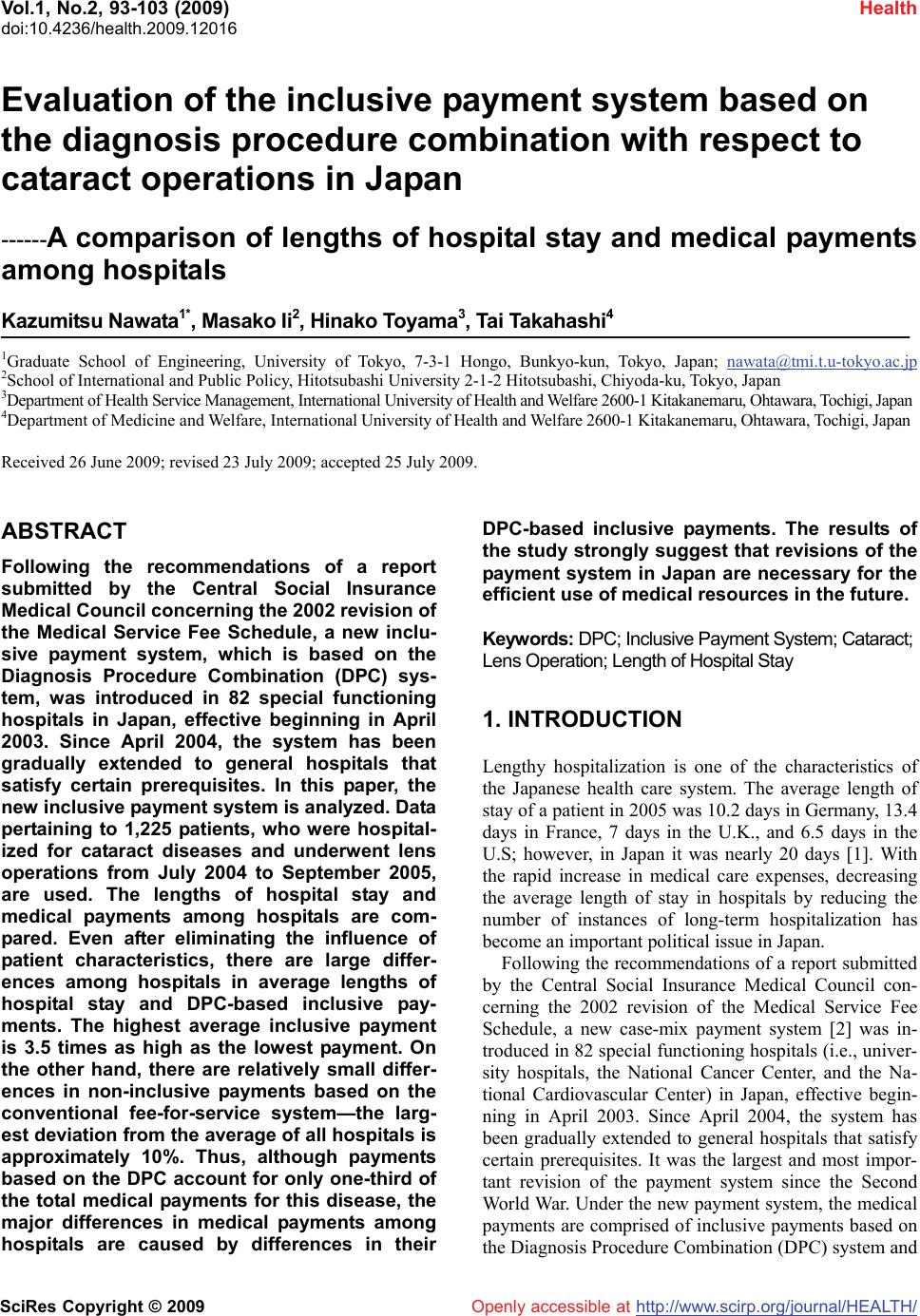 Vol.1, No.2, 93-103 (2009) doi:10.4236/health.2009.12016 SciRes Copyright © 2009 http://www.scirp.org/journal/HEALTH/ Health Openly accessible at Evaluation of the inclusive payment system based on the diagnosis procedure combination with respect to cataract operations in Japan ------A comparison of lengths of hospital stay and medical payments among hospitals Kazumitsu Nawata1*, Masako Ii2, Hinako Toyama3, Tai Takahashi4 1Graduate School of Engineering, University of Tokyo, 7-3-1 Hongo, Bunkyo-kun, Tokyo, Japan; nawata@tmi.t.u-tokyo.ac.jp 2School of International and Public Policy, Hitotsubashi University 2-1-2 Hitotsubashi, Chiyoda-ku, Tokyo, Japan 3Department of Health Service Management, International University of Health and Welfare 2600-1 Kitakanemaru, Ohtawara, Tochigi, Japan 4Department of Medicine and Welfare, International University of Health and Welfare 2600-1 Kitakanemaru, Ohtawara, Tochigi, Japan Received 26 June 2009; revised 23 July 2009; accepted 25 July 2009. ABSTRACT Following the recommendations of a report submitted by the Central Social Insurance Medical Council concerning the 2002 revision of the Medical Service Fee Schedule, a new inclu- sive payment system, which is based on the Diagnosis Procedure Combination (DPC) sys- tem, was introduced in 82 special functioning hospitals in Japan, effective beginning in April 2003. Since April 2004, the system has been gradually extended to general hospitals that satisfy certain prerequisites. In this paper, the new inclusive payment system is analyzed. Data pertaining to 1,225 patients, who were hospital- ized for cataract diseases and underwent lens operations from July 2004 to September 2005, are used. The lengths of hospital stay and medical payments among hospitals are com- pared. Even after eliminating the influence of patient characteristics, there are large differ- ences among hospitals in average lengths of hospital stay and DPC-based inclusive pay- ments. The highest average inclusive payment is 3.5 times as high as the lowest payment. On the other hand, there are relatively small differ- ences in non-inclusive payments based on the conventional fee-for-service system—the larg- est deviation from the average of all hospitals is approximately 10%. Thus, although payments based on the DPC account for only one-third of the total medical payments for this disease, the major differences in medical payments among hospitals are caused by differences in their DPC-based inclusive payments. The results of the study strongly suggest that revisions of the payment system in Japan are necessary for the efficient use of medical resources in the future. Keywords: DPC; Inclusive Payment System; Cataract; Lens Operation; Length of Hospital Stay 1. INTRODUCTION Lengthy hospitalization is one of the characteristics of the Japanese health care system. The average length of stay of a patient in 2005 was 10.2 days in Germany, 13.4 days in France, 7 days in the U.K., and 6.5 days in the U.S; however, in Japan it was nearly 20 days [1]. With the rapid increase in medical care expenses, decreasing the average length of stay in hospitals by reducing the number of instances of long-term hospitalization has become an important political issue in Japan. Following the recommendations of a report submitted by the Central Social Insurance Medical Council con- cerning the 2002 revision of the Medical Service Fee Schedule, a new case-mix payment system [2] was in- troduced in 82 special functioning hospitals (i.e., univer- sity hospitals, the National Cancer Center, and the Na- tional Cardiovascular Center) in Japan, effective begin- ning in April 2003. Since April 2004, the system has been gradually extended to general hospitals that satisfy certain prerequisites. It was the largest and most impor- tant revision of the payment system since the Second World War. Under the new payment system, the medical payments are comprised of inclusive payments based on the Diagnosis Procedure Combination (DPC) system and 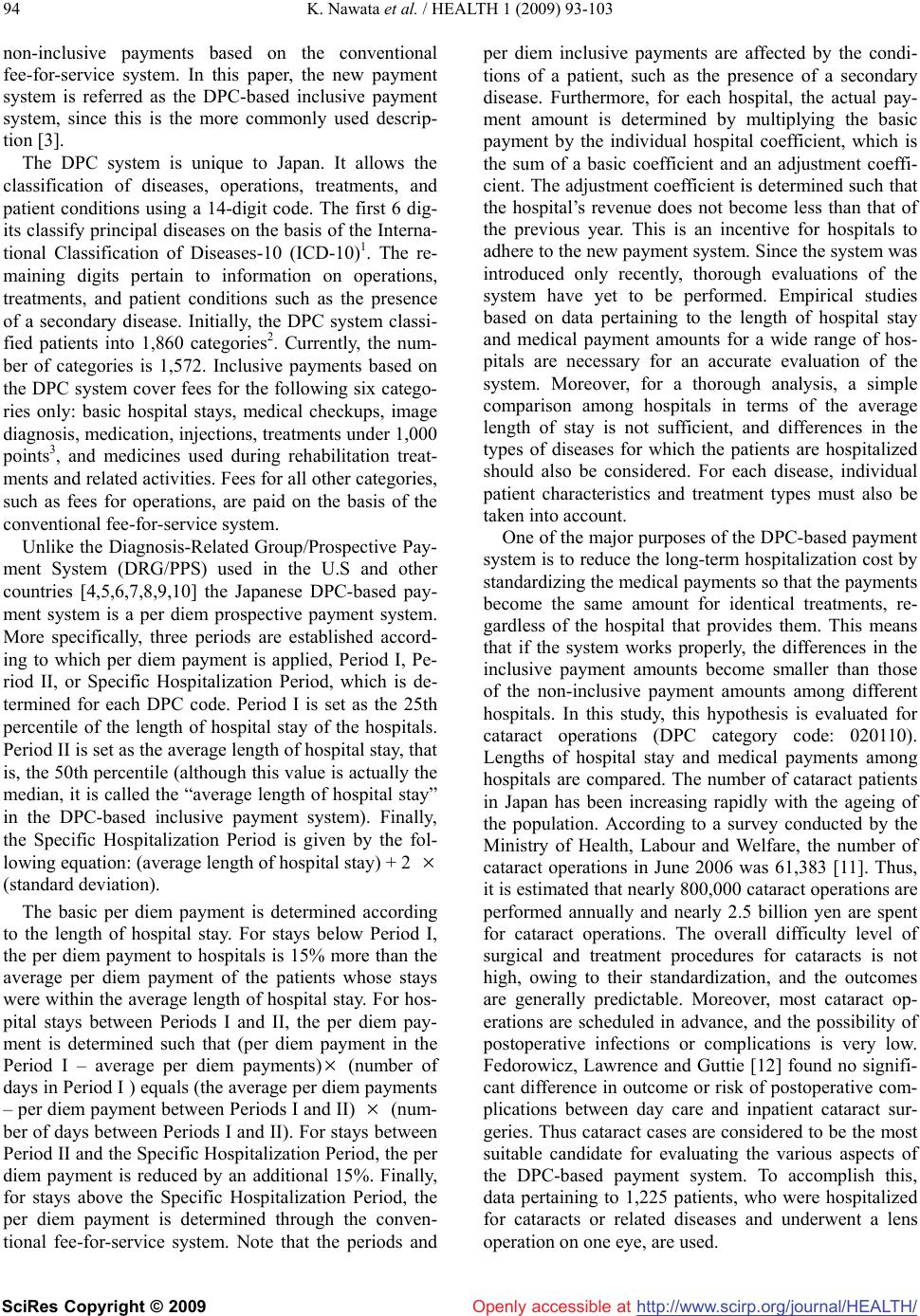 K. Nawata et al. / HEALTH 1 (2009) 93-103 http://www.scirp.org/journal/HEALTH/ 94 Openly accessible at non-inclusive payments based on the conventional fee-for-service system. In this paper, the new payment system is referred as the DPC-based inclusive payment system, since this is the more commonly used descrip- tion [3]. The DPC system is unique to Japan. It allows the classification of diseases, operations, treatments, and patient conditions using a 14-digit code. The first 6 dig- its classify principal diseases on the basis of the Interna- tional Classification of Diseases-10 (ICD-10)1. The re- maining digits pertain to information on operations, treatments, and patient conditions such as the presence of a secondary disease. Initially, the DPC system classi- fied patients into 1,860 categories2. Currently, the num- ber of categories is 1,572. Inclusive payments based on the DPC system cover fees for the following six catego- ries only: basic hospital stays, medical checkups, image diagnosis, medication, injections, treatments under 1,000 points3, and medicines used during rehabilitation treat- ments and related activities. Fees for all other categories, such as fees for operations, are paid on the basis of the conventional fee-for-service system. Unlike the Diagnosis-Related Group/Prospective Pay- ment System (DRG/PPS) used in the U.S and other countries [4,5,6,7,8,9,10] the Japanese DPC-based pay- ment system is a per diem prospective payment system. More specifically, three periods are established accord- ing to which per diem payment is applied, Period I, Pe- riod II, or Specific Hospitalization Period, which is de- termined for each DPC code. Period I is set as the 25th percentile of the length of hospital stay of the hospitals. Period II is set as the average length of hospital stay, that is, the 50th percentile (although this value is actually the median, it is called the “average length of hospital stay” in the DPC-based inclusive payment system). Finally, the Specific Hospitalization Period is given by the fol- lowing equation: (average length of hospital stay) + 2 (standard deviation). The basic per diem payment is determined according to the length of hospital stay. For stays below Period I, the per diem payment to hospitals is 15% more than the average per diem payment of the patients whose stays were within the average length of hospital stay. For hos- pital stays between Periods I and II, the per diem pay- ment is determined such that (per diem payment in the Period I – average per diem payments) (number of days in Period I ) equals (the average per diem payments – per diem payment between Periods I and II) (num- ber of days between Periods I and II). For stays between Period II and the Specific Hospitalization Period, the per diem payment is reduced by an additional 15%. Finally, for stays above the Specific Hospitalization Period, the per diem payment is determined through the conven- tional fee-for-service system. Note that the periods and per diem inclusive payments are affected by the condi- tions of a patient, such as the presence of a secondary disease. Furthermore, for each hospital, the actual pay- ment amount is determined by multiplying the basic payment by the individual hospital coefficient, which is the sum of a basic coefficient and an adjustment coeffi- cient. The adjustment coefficient is determined such that the hospital’s revenue does not become less than that of the previous year. This is an incentive for hospitals to adhere to the new payment system. Since the system was introduced only recently, thorough evaluations of the system have yet to be performed. Empirical studies based on data pertaining to the length of hospital stay and medical payment amounts for a wide range of hos- pitals are necessary for an accurate evaluation of the system. Moreover, for a thorough analysis, a simple comparison among hospitals in terms of the average length of stay is not sufficient, and differences in the types of diseases for which the patients are hospitalized should also be considered. For each disease, individual patient characteristics and treatment types must also be taken into account. One of the major purposes of the DPC-based payment system is to reduce the long-term hospitalization cost by standardizing the medical payments so that the payments become the same amount for identical treatments, re- gardless of the hospital that provides them. This means that if the system works properly, the differences in the inclusive payment amounts become smaller than those of the non-inclusive payment amounts among different hospitals. In this study, this hypothesis is evaluated for cataract operations (DPC category code: 020110). Lengths of hospital stay and medical payments among hospitals are compared. The number of cataract patients in Japan has been increasing rapidly with the ageing of the population. According to a survey conducted by the Ministry of Health, Labour and Welfare, the number of cataract operations in June 2006 was 61,383 [11]. Thus, it is estimated that nearly 800,000 cataract operations are performed annually and nearly 2.5 billion yen are spent for cataract operations. The overall difficulty level of surgical and treatment procedures for cataracts is not high, owing to their standardization, and the outcomes are generally predictable. Moreover, most cataract op- erations are scheduled in advance, and the possibility of postoperative infections or complications is very low. Fedorowicz, Lawrence and Guttie [12] found no signifi- cant difference in outcome or risk of postoperative com- plications between day care and inpatient cataract sur- geries. Thus cataract cases are considered to be the most suitable candidate for evaluating the various aspects of the DPC-based payment system. To accomplish this, data pertaining to 1,225 patients, who were hospitalized for cataracts or related diseases and underwent a lens peration on one eye, are used. o SciRes Copyright © 2009 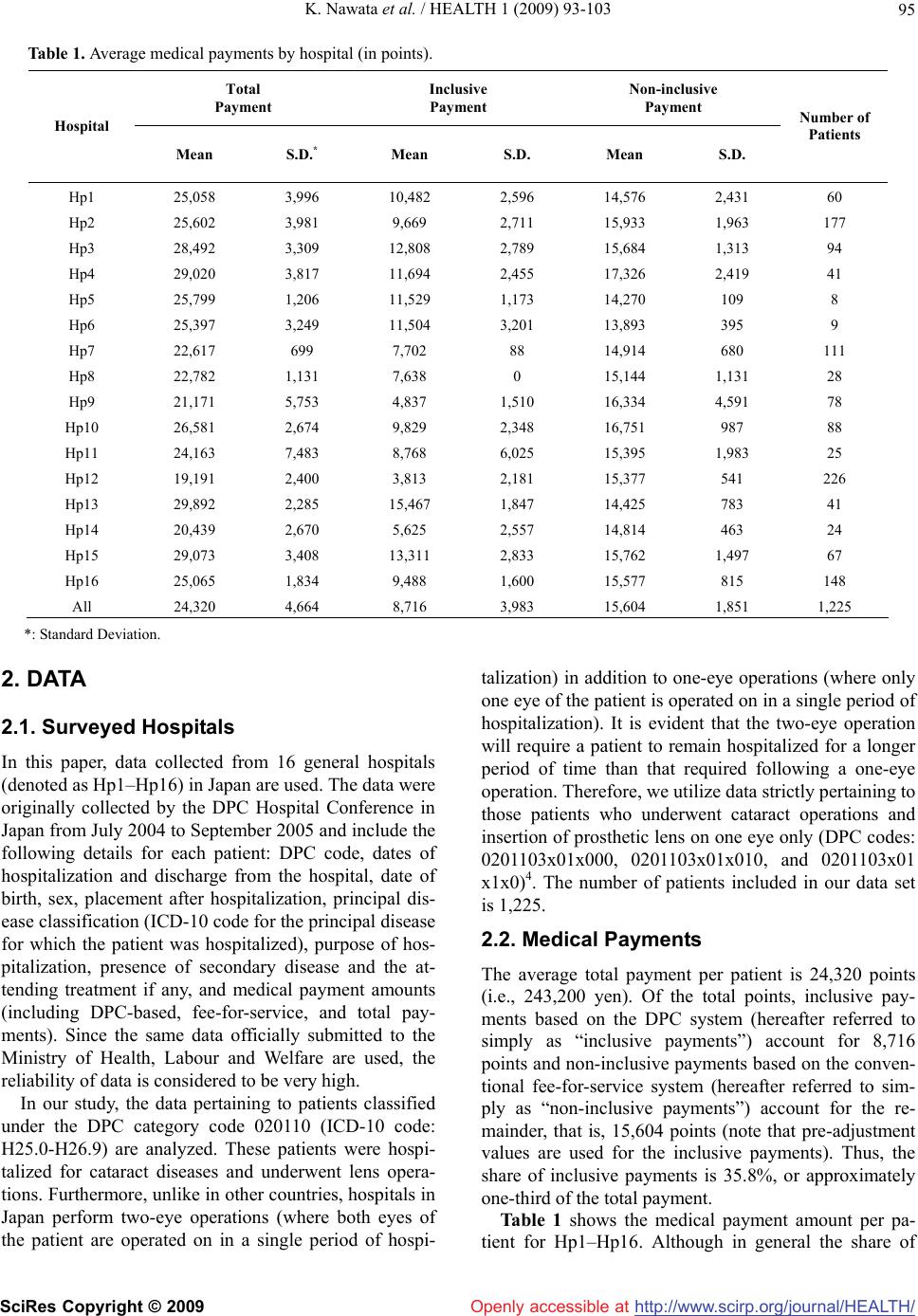 K. Nawata et al. / HEALTH 1 (2009) 93-103 SciRes Copyright © 2009 http://www.scirp.org/journal/HEALTH/Openly accessible at 95 Table 1. Average medical payments by hospital (in points). Total Payment Inclusive Payment Non-inclusive Payment Hospital Mean S.D.* Mean S.D. Mean S.D. Number of Patients Hp1 25,058 3,996 10,482 2,596 14,576 2,431 60 Hp2 25,602 3,981 9,669 2,711 15,933 1,963 177 Hp3 28,492 3,309 12,808 2,789 15,684 1,313 94 Hp4 29,020 3,817 11,694 2,455 17,326 2,419 41 Hp5 25,799 1,206 11,529 1,173 14,270 109 8 Hp6 25,397 3,249 11,504 3,201 13,893 395 9 Hp7 22,617 699 7,702 88 14,914 680 111 Hp8 22,782 1,131 7,638 0 15,144 1,131 28 Hp9 21,171 5,753 4,837 1,510 16,334 4,591 78 Hp10 26,581 2,674 9,829 2,348 16,751 987 88 Hp11 24,163 7,483 8,768 6,025 15,395 1,983 25 Hp12 19,191 2,400 3,813 2,181 15,377 541 226 Hp13 29,892 2,285 15,467 1,847 14,425 783 41 Hp14 20,439 2,670 5,625 2,557 14,814 463 24 Hp15 29,073 3,408 13,311 2,833 15,762 1,497 67 Hp16 25,065 1,834 9,488 1,600 15,577 815 148 All 24,320 4,664 8,716 3,983 15,604 1,851 1,225 *: Standard Deviation. 2. DATA 2.1. Surveyed Hospitals In this paper, data collected from 16 general hospitals (denoted as Hp1–Hp16) in Japan are used. The data were originally collected by the DPC Hospital Conference in Japan from July 2004 to September 2005 and include the following details for each patient: DPC code, dates of hospitalization and discharge from the hospital, date of birth, sex, placement after hospitalization, principal dis- ease classification (ICD-10 code for the principal disease for which the patient was hospitalized), purpose of hos- pitalization, presence of secondary disease and the at- tending treatment if any, and medical payment amounts (including DPC-based, fee-for-service, and total pay- ments). Since the same data officially submitted to the Ministry of Health, Labour and Welfare are used, the reliability of data is considered to be very high. In our study, the data pertaining to patients classified under the DPC category code 020110 (ICD-10 code: H25.0-H26.9) are analyzed. These patients were hospi- talized for cataract diseases and underwent lens opera- tions. Furthermore, unlike in other countries, hospitals in Japan perform two-eye operations (where both eyes of the patient are operated on in a single period of hospi- talization) in addition to one-eye operations (where only one eye of the patient is operated on in a single period of hospitalization). It is evident that the two-eye operation will require a patient to remain hospitalized for a longer period of time than that required following a one-eye operation. Therefore, we utilize data strictly pertaining to those patients who underwent cataract operations and insertion of prosthetic lens on one eye only (DPC codes: 0201103x01x000, 0201103x01x010, and 0201103x01 x1x0)4. The number of patients included in our data set is 1,225. 2.2. Medical Payments The average total payment per patient is 24,320 points (i.e., 243,200 yen). Of the total points, inclusive pay- ments based on the DPC system (hereafter referred to simply as “inclusive payments”) account for 8,716 points and non-inclusive payments based on the conven- tional fee-for-service system (hereafter referred to sim- ply as “non-inclusive payments”) account for the re- mainder, that is, 15,604 points (note that pre-adjustment values are used for the inclusive payments). Thus, the share of inclusive payments is 35.8%, or approximately one-third of the total payment. Table 1 shows the medical payment amount per pa- tient for Hp1–Hp16. Although in general the share of 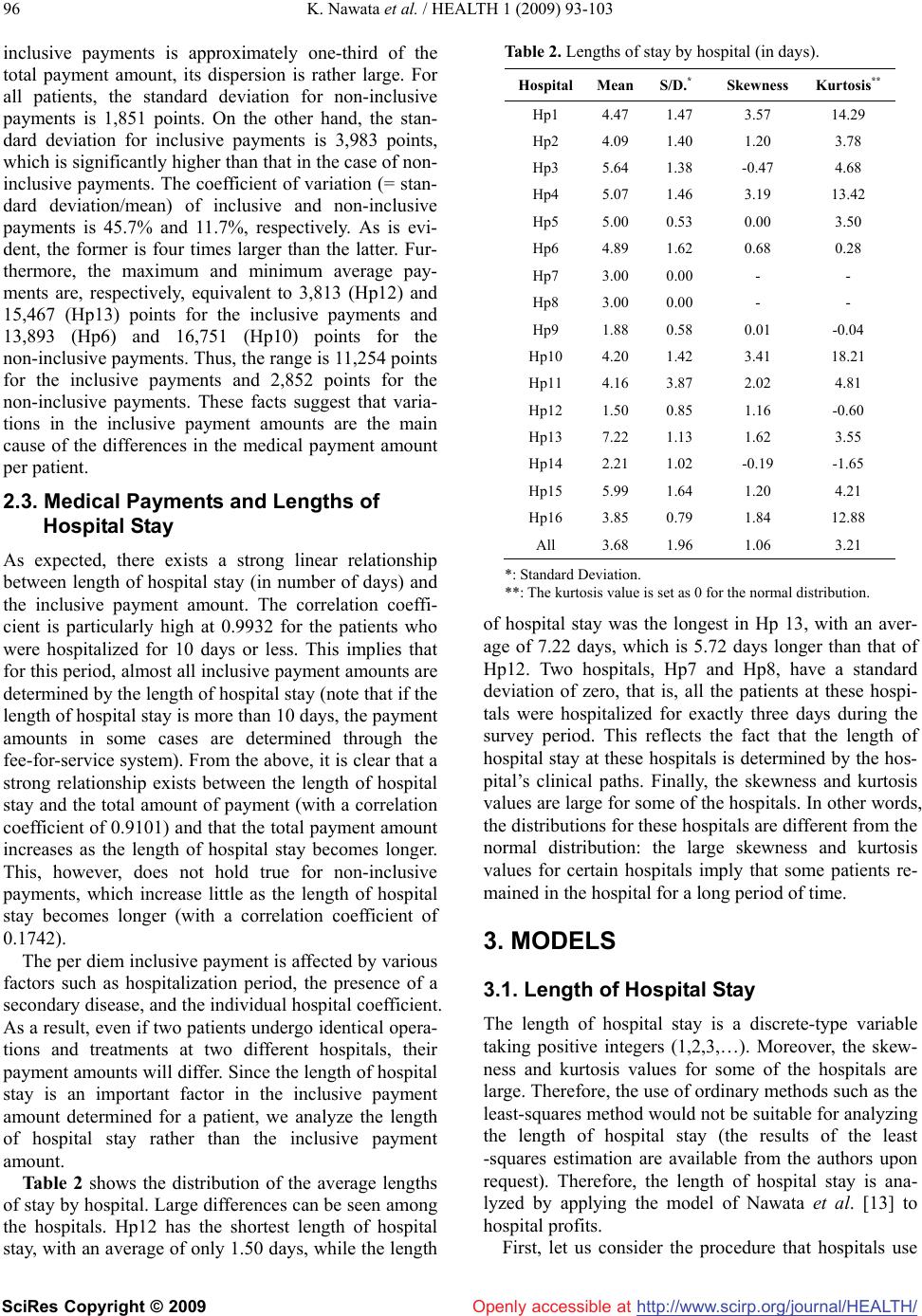 K. Nawata et al. / HEALTH 1 (2009) 93-103 http://www.scirp.org/journal/HEALTH/ 96 Openly accessible at inclusive payments is approximately one-third of the total payment amount, its dispersion is rather large. For all patients, the standard deviation for non-inclusive payments is 1,851 points. On the other hand, the stan- dard deviation for inclusive payments is 3,983 points, which is significantly higher than that in the case of non- inclusive payments. The coefficient of variation (= stan- dard deviation/mean) of inclusive and non-inclusive payments is 45.7% and 11.7%, respectively. As is evi- dent, the former is four times larger than the latter. Fur- thermore, the maximum and minimum average pay- ments are, respectively, equivalent to 3,813 (Hp12) and 15,467 (Hp13) points for the inclusive payments and 13,893 (Hp6) and 16,751 (Hp10) points for the non-inclusive payments. Thus, the range is 11,254 points for the inclusive payments and 2,852 points for the non-inclusive payments. These facts suggest that varia- tions in the inclusive payment amounts are the main cause of the differences in the medical payment amount per patient. 2.3. Medical Payments and Lengths of Hospital Stay As expected, there exists a strong linear relationship between length of hospital stay (in number of days) and the inclusive payment amount. The correlation coeffi- cient is particularly high at 0.9932 for the patients who were hospitalized for 10 days or less. This implies that for this period, almost all inclusive payment amounts are determined by the length of hospital stay (note that if the length of hospital stay is more than 10 days, the payment amounts in some cases are determined through the fee-for-service system). From the above, it is clear that a strong relationship exists between the length of hospital stay and the total amount of payment (with a correlation coefficient of 0.9101) and that the total payment amount increases as the length of hospital stay becomes longer. This, however, does not hold true for non-inclusive payments, which increase little as the length of hospital stay becomes longer (with a correlation coefficient of 0.1742). The per diem inclusive payment is affected by various factors such as hospitalization period, the presence of a secondary disease, and the individual hospital coefficient. As a result, even if two patients undergo identical opera- tions and treatments at two different hospitals, their payment amounts will differ. Since the length of hospital stay is an important factor in the inclusive payment amount determined for a patient, we analyze the length of hospital stay rather than the inclusive payment amount. Table 2 shows the distribution of the average lengths of stay by hospital. Large differences can be seen among the hospitals. Hp12 has the shortest length of hospital stay, with an average of only 1.50 days, while the length Table 2. Lengths of stay by hospital (in days). Hospital MeanS/D.* Skewness Kurtosis** Hp1 4.47 1.47 3.57 14.29 Hp2 4.09 1.40 1.20 3.78 Hp3 5.64 1.38 -0.47 4.68 Hp4 5.07 1.46 3.19 13.42 Hp5 5.00 0.53 0.00 3.50 Hp6 4.89 1.62 0.68 0.28 Hp7 3.00 0.00 - - Hp8 3.00 0.00 - - Hp9 1.88 0.58 0.01 -0.04 Hp10 4.20 1.42 3.41 18.21 Hp11 4.16 3.87 2.02 4.81 Hp12 1.50 0.85 1.16 -0.60 Hp13 7.22 1.13 1.62 3.55 Hp14 2.21 1.02 -0.19 -1.65 Hp15 5.99 1.64 1.20 4.21 Hp16 3.85 0.79 1.84 12.88 All 3.68 1.96 1.06 3.21 *: Standard Deviation. **: The kurtosis value is set as 0 for the normal distribution. of hospital stay was the longest in Hp 13, with an aver- age of 7.22 days, which is 5.72 days longer than that of Hp12. Two hospitals, Hp7 and Hp8, have a standard deviation of zero, that is, all the patients at these hospi- tals were hospitalized for exactly three days during the survey period. This reflects the fact that the length of hospital stay at these hospitals is determined by the hos- pital’s clinical paths. Finally, the skewness and kurtosis values are large for some of the hospitals. In other words, the distributions for these hospitals are different from the normal distribution: the large skewness and kurtosis values for certain hospitals imply that some patients re- mained in the hospital for a long period of time. 3. MODELS 3.1. Length of Hospital Stay The length of hospital stay is a discrete-type variable taking positive integers (1,2,3,…). Moreover, the skew- ness and kurtosis values for some of the hospitals are large. Therefore, the use of ordinary methods such as the least-squares method would not be suitable for analyzing the length of hospital stay (the results of the least -squares estimation are available from the authors upon request). Therefore, the length of hospital stay is ana- lyzed by applying the model of Nawata et al. [13] to hospital profits. First, let us consider the procedure that hospitals use SciRes Copyright © 2009 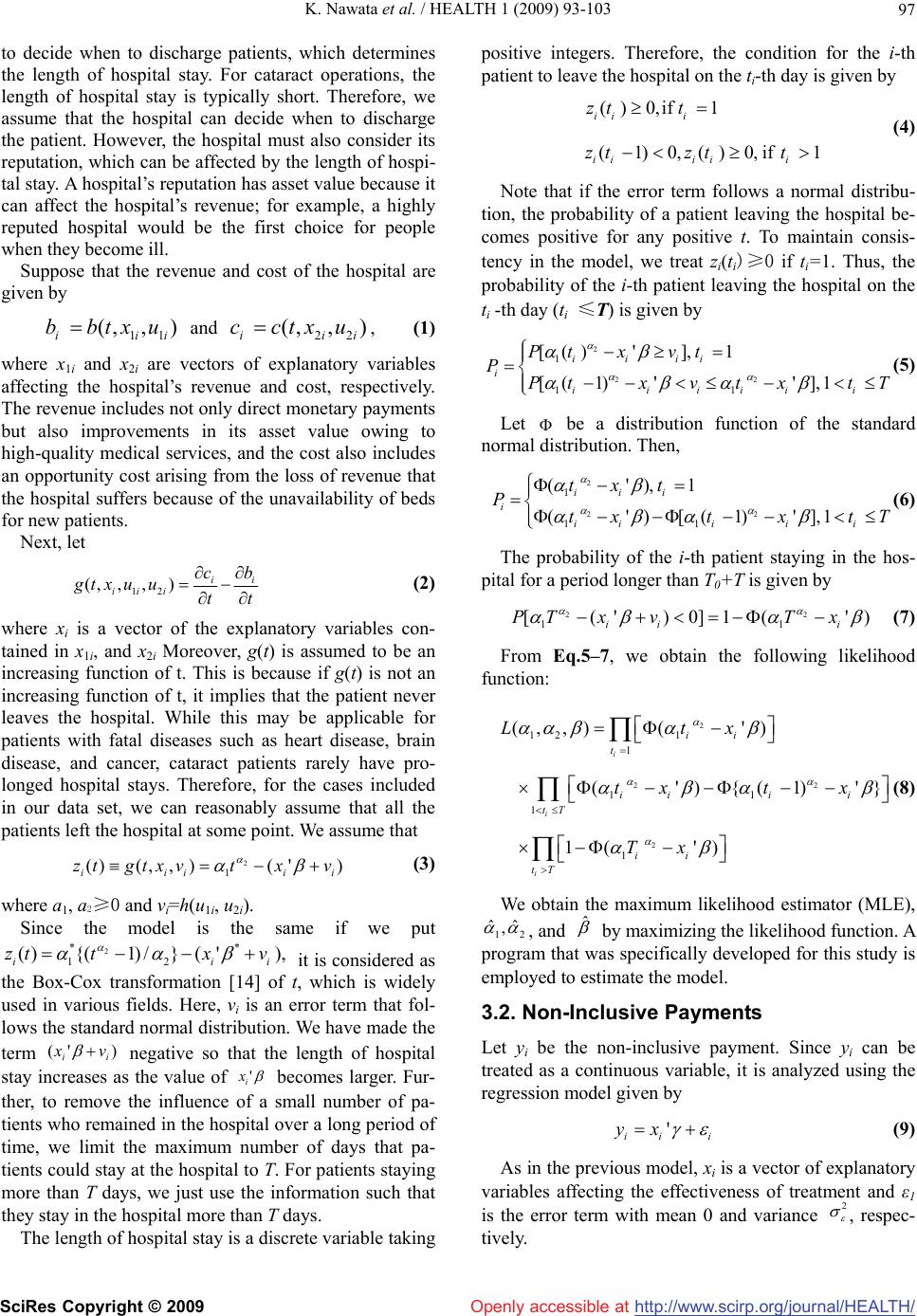 K. Nawata et al. / HEALTH 1 (2009) 93-103 http://www.scirp.org/journal/HEALTH/ 97 Openly accessible at to decide when to discharge patients, which determines the length of hospital stay. For cataract operations, the length of hospital stay is typically short. Therefore, we assume that the hospital can decide when to discharge the patient. However, the hospital must also consider its reputation, which can be affected by the length of hospi- tal stay. A hospital’s reputation has asset value because it can affect the hospital’s revenue; for example, a highly reputed hospital would be the first choice for people when they become ill. Suppose that the revenue and cost of the hospital are given by ),,( 11iii uxtbb and , (1) ),,(22 iii uxtcc where x1i and x2i are vectors of explanatory variables affecting the hospital’s revenue and cost, respectively. The revenue includes not only direct monetary payments but also improvements in its asset value owing to high-quality medical services, and the cost also includes an opportunity cost arising from the loss of revenue that the hospital suffers because of the unavailability of beds for new patients. Next, let 12 (, ,,)i ii i cb gtxuutt i 1 (2) where xi is a vector of the explanatory variables con- tained in x1i, and x2i Moreover, g(t) is assumed to be an increasing function of t. This is because if g(t) is not an increasing function of t, it implies that the patient never leaves the hospital. While this may be applicable for patients with fatal diseases such as heart disease, brain disease, and cancer, cataract patients rarely have pro- longed hospital stays. Therefore, for the cases included in our data set, we can reasonably assume that all the patients left the hospital at some point. We assume that )'(),,()( 2 1iiiiivxtvxtgtz (3) where a1, a2≥0 and vi=h(u1i, u2i). Since the model is the same if we put it is considered as the Box-Cox transformation [14] of t, which is widely used in various fields. Here, vi is an error term that fol- lows the standard normal distribution. We have made the term negative so that the length of hospital stay increases as the value of becomes larger. Fur- ther, to remove the influence of a small number of pa- tients who remained in the hospital over a long period of time, we limit the maximum number of days that pa- tients could stay at the hospital to T. For patients staying more than T days, we just use the information such that they stay in the hospital more than T days. ),'(}/)1{()( * 2 * 1 2 iii vxttz )'( ii vx ' i x The length of hospital stay is a discrete variable taking positive integers. Therefore, the condition for the i-th patient to leave the hospital on the ti-th day is given by ()0,if 1 ii i zt t (4) (1)0,()0,if iiii i ztzt t Note that if the error term follows a normal distribu- tion, the probability of a patient leaving the hospital be- comes positive for any positive t. To maintain consis- tency in the model, we treat zi(ti)≥0 if ti=1. Thus, the probability of the i-th patient leaving the hospital on the ti -th day (ti ≤T) is given by 2 22 1 11 [()'], 1 [( 1)''],1 iiii i iiiiii Ptx vt PPtxvt xtT (5) Let be a distribution function of the standard normal distribution. Then, 2 22 1 11 ('),1 (')[(1)'],1 iii i iiii i txt Ptxtx t T (6) The probability of the i-th patient staying in the hos- pital for a period longer than T0+T is given by 22 11 [(')0]1( ' ii i PTxvT x ) (7) From Eq.5–7, we obtain the following likelihood function: 2 22 2 12 1 1 11 1 1 (, ,)(') ('){(1)' 1( ') i i i ii t iii i tT ii tT Ltx txt x Tx } (8) We obtain the maximum likelihood estimator (MLE), 21ˆ , ˆ , and ˆ by maximizing the likelihood function. A program that was specifically developed for this study is employed to estimate the model. 3.2. Non-Inclusive Payments Let yi be the non-inclusive payment. Since yi can be treated as a continuous variable, it is analyzed using the regression model given by ' ii yx i (9) As in the previous model, xi is a vector of explanatory variables affecting the effectiveness of treatment and ε1 is the error term with mean 0 and variance 2 , respec- tively. SciRes Copyright © 2009 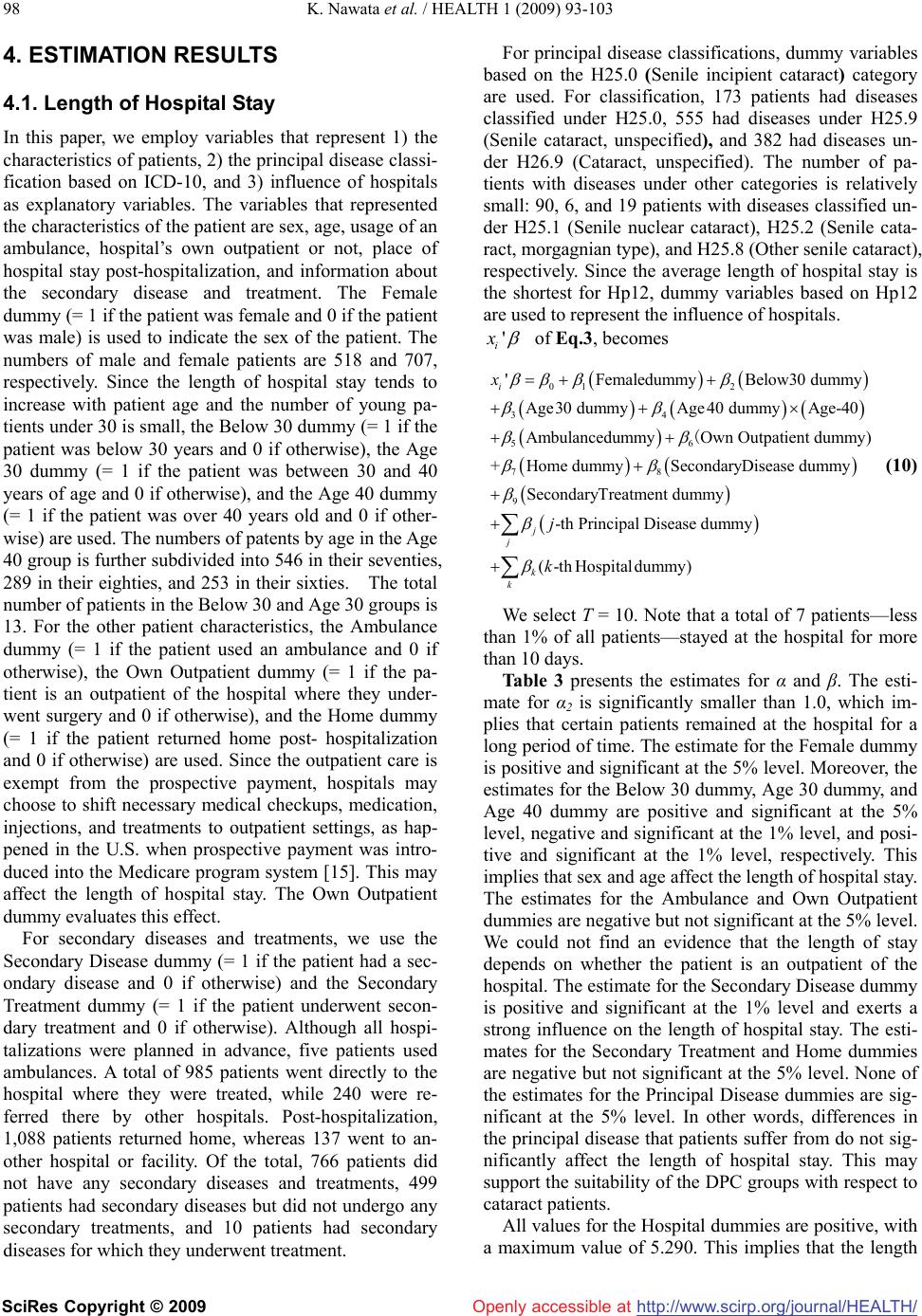 K. Nawata et al. / HEALTH 1 (2009) 93-103 http://www.scirp.org/journal/HEALTH/ 98 Openly accessible at 4. ESTIMATION RESULTS 4.1. Length of Hospital Stay In this paper, we employ variables that represent 1) the characteristics of patients, 2) the principal disease classi- fication based on ICD-10, and 3) influence of hospitals as explanatory variables. The variables that represented the characteristics of the patient are sex, age, usage of an ambulance, hospital’s own outpatient or not, place of hospital stay post-hospitalization, and information about the secondary disease and treatment. The Female dummy (= 1 if the patient was female and 0 if the patient was male) is used to indicate the sex of the patient. The numbers of male and female patients are 518 and 707, respectively. Since the length of hospital stay tends to increase with patient age and the number of young pa- tients under 30 is small, the Below 30 dummy (= 1 if the patient was below 30 years and 0 if otherwise), the Age 30 dummy (= 1 if the patient was between 30 and 40 years of age and 0 if otherwise), and the Age 40 dummy (= 1 if the patient was over 40 years old and 0 if other- wise) are used. The numbers of patents by age in the Age 40 group is further subdivided into 546 in their seventies, 289 in their eighties, and 253 in their sixties. The total number of patients in the Below 30 and Age 30 groups is 13. For the other patient characteristics, the Ambulance dummy (= 1 if the patient used an ambulance and 0 if otherwise), the Own Outpatient dummy (= 1 if the pa- tient is an outpatient of the hospital where they under- went surgery and 0 if otherwise), and the Home dummy (= 1 if the patient returned home post- hospitalization and 0 if otherwise) are used. Since the outpatient care is exempt from the prospective payment, hospitals may choose to shift necessary medical checkups, medication, injections, and treatments to outpatient settings, as hap- pened in the U.S. when prospective payment was intro- duced into the Medicare program system [15]. This may affect the length of hospital stay. The Own Outpatient dummy evaluates this effect. For secondary diseases and treatments, we use the Secondary Disease dummy (= 1 if the patient had a sec- ondary disease and 0 if otherwise) and the Secondary Treatment dummy (= 1 if the patient underwent secon- dary treatment and 0 if otherwise). Although all hospi- talizations were planned in advance, five patients used ambulances. A total of 985 patients went directly to the hospital where they were treated, while 240 were re- ferred there by other hospitals. Post-hospitalization, 1,088 patients returned home, whereas 137 went to an- other hospital or facility. Of the total, 766 patients did not have any secondary diseases and treatments, 499 patients had secondary diseases but did not undergo any secondary treatments, and 10 patients had secondary diseases for which they underwent treatment. For principal disease classifications, dummy variables based on the H25.0 (Senile incipient cataract) category are used. For classification, 173 patients had diseases classified under H25.0, 555 had diseases under H25.9 (Senile cataract, unspecified), and 382 had diseases un- der H26.9 (Cataract, unspecified). The number of pa- tients with diseases under other categories is relatively small: 90, 6, and 19 patients with diseases classified un- der H25.1 (Senile nuclear cataract), H25.2 (Senile cata- ract, morgagnian type), and H25.8 (Other senile cataract), respectively. Since the average length of hospital stay is the shortest for Hp12, dummy variables based on Hp12 are used to represent the influence of hospitals. ' i x of Eq.3, becomes 012 34 56 78 9 'FemaledummyBelow30 dummy Age30 dummyAge40 dummyAge-40 AmbulancedummyOwn Outpatient dummy) +Home dummySecondaryDisease dummy SecondaryTreatment dummy -th Principal i j j x j ( Disease dummy (-th Hospitaldummy) k k k (10) We select T = 10. Note that a total of 7 patients—less than 1% of all patients—stayed at the hospital for more than 10 days. Table 3 presents the estimates for α and β. The esti- mate for α2 is significantly smaller than 1.0, which im- plies that certain patients remained at the hospital for a long period of time. The estimate for the Female dummy is positive and significant at the 5% level. Moreover, the estimates for the Below 30 dummy, Age 30 dummy, and Age 40 dummy are positive and significant at the 5% level, negative and significant at the 1% level, and posi- tive and significant at the 1% level, respectively. This implies that sex and age affect the length of hospital stay. The estimates for the Ambulance and Own Outpatient dummies are negative but not significant at the 5% level. We could not find an evidence that the length of stay depends on whether the patient is an outpatient of the hospital. The estimate for the Secondary Disease dummy is positive and significant at the 1% level and exerts a strong influence on the length of hospital stay. The esti- mates for the Secondary Treatment and Home dummies are negative but not significant at the 5% level. None of the estimates for the Principal Disease dummies are sig- nificant at the 5% level. In other words, differences in the principal disease that patients suffer from do not sig- nificantly affect the length of hospital stay. This may support the suitability of the DPC groups with respect to cataract patients. All values for the Hospital dummies are positive, with a maximum value of 5.290. This implies that the length SciRes Copyright © 2009 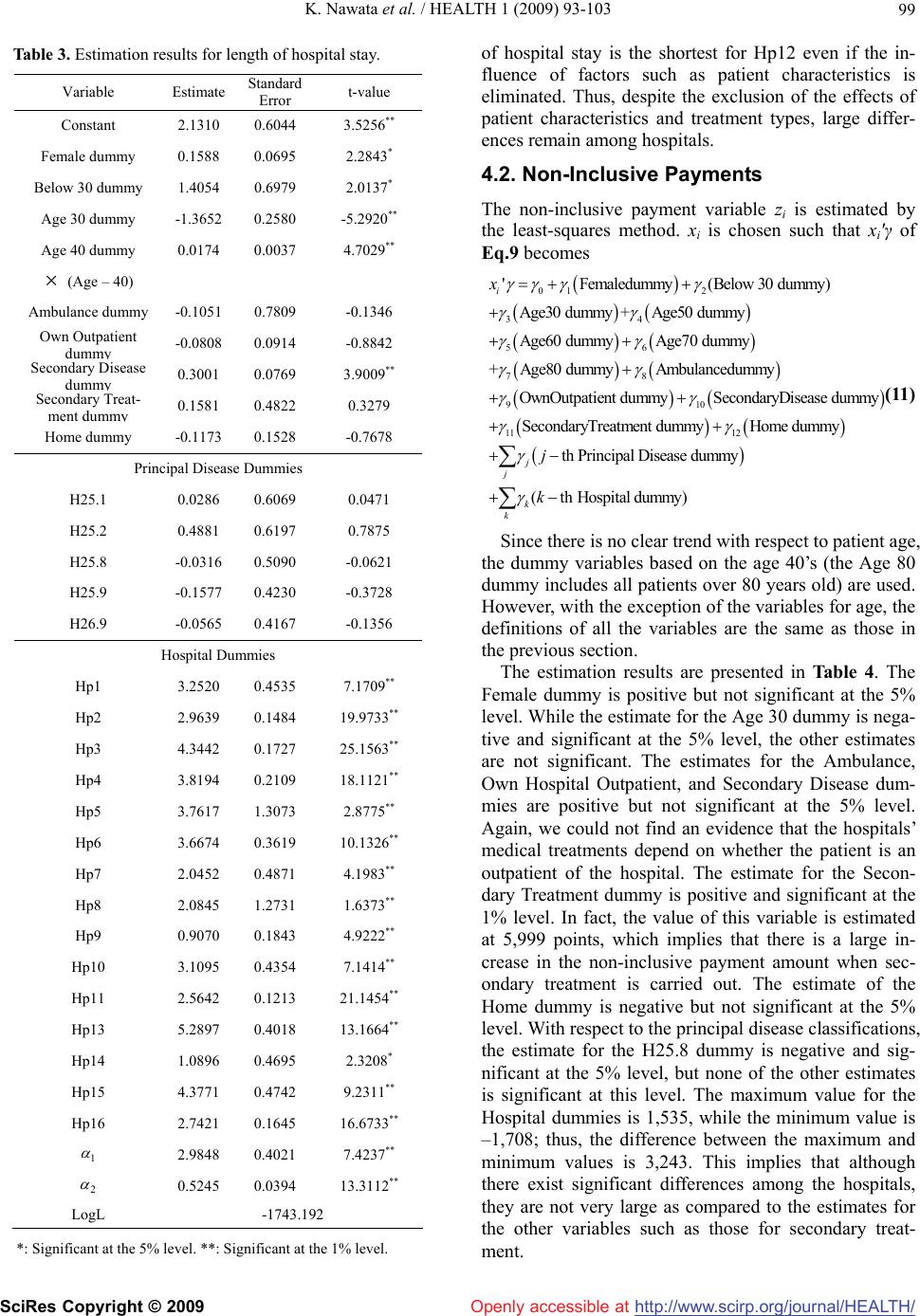 K. Nawata et al. / HEALTH 1 (2009) 93-103 http://www.scirp.org/journal/HEALTH/ 99 Openly accessible at Table 3. Estimation results for length of hospital stay. Variable EstimateStandard Error t-value Constant 2.1310 0.6044 3.5256** Female dummy 0.1588 0.0695 2.2843* Below 30 dummy 1.4054 0.6979 2.0137* Age 30 dummy -1.3652 0.2580 -5.2920** Age 40 dummy 0.0174 0.0037 4.7029** (Age – 40) Ambulance dummy -0.1051 0.7809 -0.1346 Own Outpatient mm -0.0808 0.0914 -0.8842 Secondary Disease mm 0.3001 0.0769 3.9009** Secondary Treat- m n mm 0.1581 0.4822 0.3279 Home dummy -0.1173 0.1528 -0.7678 Principal Disease Dummies H25.1 0.0286 0.6069 0.0471 H25.2 0.4881 0.6197 0.7875 H25.8 -0.0316 0.5090 -0.0621 H25.9 -0.1577 0.4230 -0.3728 H26.9 -0.0565 0.4167 -0.1356 Hospital Dummies Hp1 3.2520 0.4535 7.1709** Hp2 2.9639 0.1484 19.9733** Hp3 4.3442 0.1727 25.1563** Hp4 3.8194 0.2109 18.1121** Hp5 3.7617 1.3073 2.8775** Hp6 3.6674 0.3619 10.1326** Hp7 2.0452 0.4871 4.1983** Hp8 2.0845 1.2731 1.6373** Hp9 0.9070 0.1843 4.9222** Hp10 3.1095 0.4354 7.1414** Hp11 2.5642 0.1213 21.1454** Hp13 5.2897 0.4018 13.1664** Hp14 1.0896 0.4695 2.3208* Hp15 4.3771 0.4742 9.2311** Hp16 2.7421 0.1645 16.6733** 1 2.9848 0.4021 7.4237** 2 0.5245 0.0394 13.3112** LogL -1743.192 *: Significant at the 5% level. **: Significant at the 1% level. of hospital stay is the shortest for Hp12 even if the in- fluence of factors such as patient characteristics is eliminated. Thus, despite the exclusion of the effects of patient characteristics and treatment types, large differ- ences remain among hospitals. 4.2. Non-Inclusive Payments The non-inclusive payment variable zi is estimated by the least-squares method. xi is chosen such that xi'γ of Eq.9 becomes 01 2 34 56 78 910 11 'Femaledummy(Below 30 dummy) Age30 dummy+Age50 dummy Age60 dummyAge70 dummy +Age80 dummyAmbulancedummy OwnOutpatient dummySecondaryDisease dummy SecondaryTreatment i x 12 dummyHome dummy th Principal Disease dummy (thHospital dummy) j j k k j k (11) Since there is no clear trend with respect to patient age, the dummy variables based on the age 40’s (the Age 80 dummy includes all patients over 80 years old) are used. However, with the exception of the variables for age, the definitions of all the variables are the same as those in the previous section. The estimation results are presented in Table 4. The Female dummy is positive but not significant at the 5% level. While the estimate for the Age 30 dummy is nega- tive and significant at the 5% level, the other estimates are not significant. The estimates for the Ambulance, Own Hospital Outpatient, and Secondary Disease dum- mies are positive but not significant at the 5% level. Again, we could not find an evidence that the hospitals’ medical treatments depend on whether the patient is an outpatient of the hospital. The estimate for the Secon- dary Treatment dummy is positive and significant at the 1% level. In fact, the value of this variable is estimated at 5,999 points, which implies that there is a large in- crease in the non-inclusive payment amount when sec- ondary treatment is carried out. The estimate of the Home dummy is negative but not significant at the 5% level. With respect to the principal disease classifications, the estimate for the H25.8 dummy is negative and sig- nificant at the 5% level, but none of the other estimates is significant at this level. The maximum value for the Hospital dummies is 1,535, while the minimum value is –1,708; thus, the difference between the maximum and minimum values is 3,243. This implies that although there exist significant differences among the hospitals, they are not very large as compared to the estimates for the other variables such as those for secondary treat- ment. SciRes Copyright © 2009  K. Nawata et al. / HEALTH 1 (2009) 93-103 http://www.scirp.org/journal/HEALTH/ 100 Openly accessible at Table 4. Estimation results for non-inclusive payments. Variable Estimate Standard Error t-value Constant 15,340 509 30.1517* Female dummy 106 94 1.1206 Below 30 dummy 232 805 0.2876 Age 30 dummy -1,004 508 -1.9776* Age 50 dummy -218 459 -0.4750 Age 60 dummy -229 421 -0.5441 Age 70 dummy -378 406 -0.9309 Age 80 dummy -198 417 -0.4749 Ambulance dummy 1,785 2,611 0.6837 Own Outpatient dummy 94 99 0.9479 Secondary Disease dummy 246 128 1.9319 Secondary Treat- ment dummy 5,999 478 12.5625** Home dummy -98 119 -0.8266 Principal Disease Dummies H25.1 401 263 1.5252 H25.2 572 441 1.2977 H25.8 783 372 2.1037* H25.9 172 245 0.7030 H26.9 42 219 0.1924 Hospital Dummies Hp1 -684 393 -1.7388 Hp2 554 169 3.2817** Hp3 232 167 1.3927 Hp4 847 224 3.7858** Hp5 -1,429 232 -6.1556** Hp6 -1,708 201 -8.4847** Hp7 -421 123 -3.4213** Hp8 -43 340 -0.1276 Hp9 839 520 1.6113 Hp10 1,535 261 5.8827** Hp11 -507 410 -1.2371 Hp13 -1,237 217 -5.6959** Hp14 -433 259 -1.6730 Hp15 -28 246 -0.1138 Hp16 -29 131 -0.2222 R2 0.231551 *: Significant at the 5% level. **: Significant at the 1% level. 5. COMPARISON OF LENGTHS OF HOSPITAL STAY AND MEDICAL PAYMENTS AMONG HOSPITALS In this section, we compare lengths of hospital stay and non-inclusive payments, taking into consideration pa- tient characteristics and principal disease classifications for each hospital. Let us consider a 70-year-old male patient whose DPC code is 0201103x01x000 (cataract operations and insertion of prosthetic lens, no secondary disease or treatment) and who does not use an ambu- lance, is an outpatient and returns home after his hospital stay, and has a principal disease classified under the ICD-10 code H25.0. Table 5 presents the patient’s esti- mated average length of hospital stay, inclusive payment amount, non-inclusive payment amount, and total pay- ment amount at each of the surveyed hospitals. The av- erage length of hospital stay is estimated as 3.99 days for all the hospitals, with a standard deviation of 1.49 days. The shortest length of hospital stay is estimated as 1.41 days in Hp12. On the other hand, the longest average length of hospital stay is estimated as 6.97 days in Hp13, Table 5. Lengths of hospital stay and medical payments after eliminating the influence of patient characteristics by hospital* Payments (in points) Hospital Length of Stay(days) Inclusive Non- inclusive Total Hp1 4.18 9,808 14,278 24,086 Hp2 3.93 9,332 15,516 24,848 Hp3 5.65 12,523 15,194 27,717 Hp4 4.95 11,243 15,809 27,052 Hp5 4.88 11,123 13,533 24,656 Hp6 4.78 10,949 13,254 24,203 Hp7 2.99 7,374 14,541 21,915 Hp8 2.98 7,339 14,919 22,258 Hp9 2.01 5,085 15,800 20,886 Hp10 4.07 9,587 16,497 26,084 Hp11 3.54 8,525 14,455 22,980 HP12 1.41 3,590 14,962 18,552 Hp13 6.97 14,772 13,725 28,497 Hp14 2.12 5,365 14,529 19,894 Hp15 5.74 12,673 14,934 27,607 Hp16 3.66 8,765 14,933 23,698 All Mean 3.99 9,253 14,805 24,058 Standard Deviation 1.49 3,013 869 2,905 *: Considering a 70-year-old male patient whose DPC code is 0201103x01x000 (cataract operations and insertion of prosthetic lens, no secondary disease or treatment) and who does not use an ambulance, is an outpatient and returns home, and has a principal disease classified under the ICD-10 code H25.0. SciRes Copyright © 2009 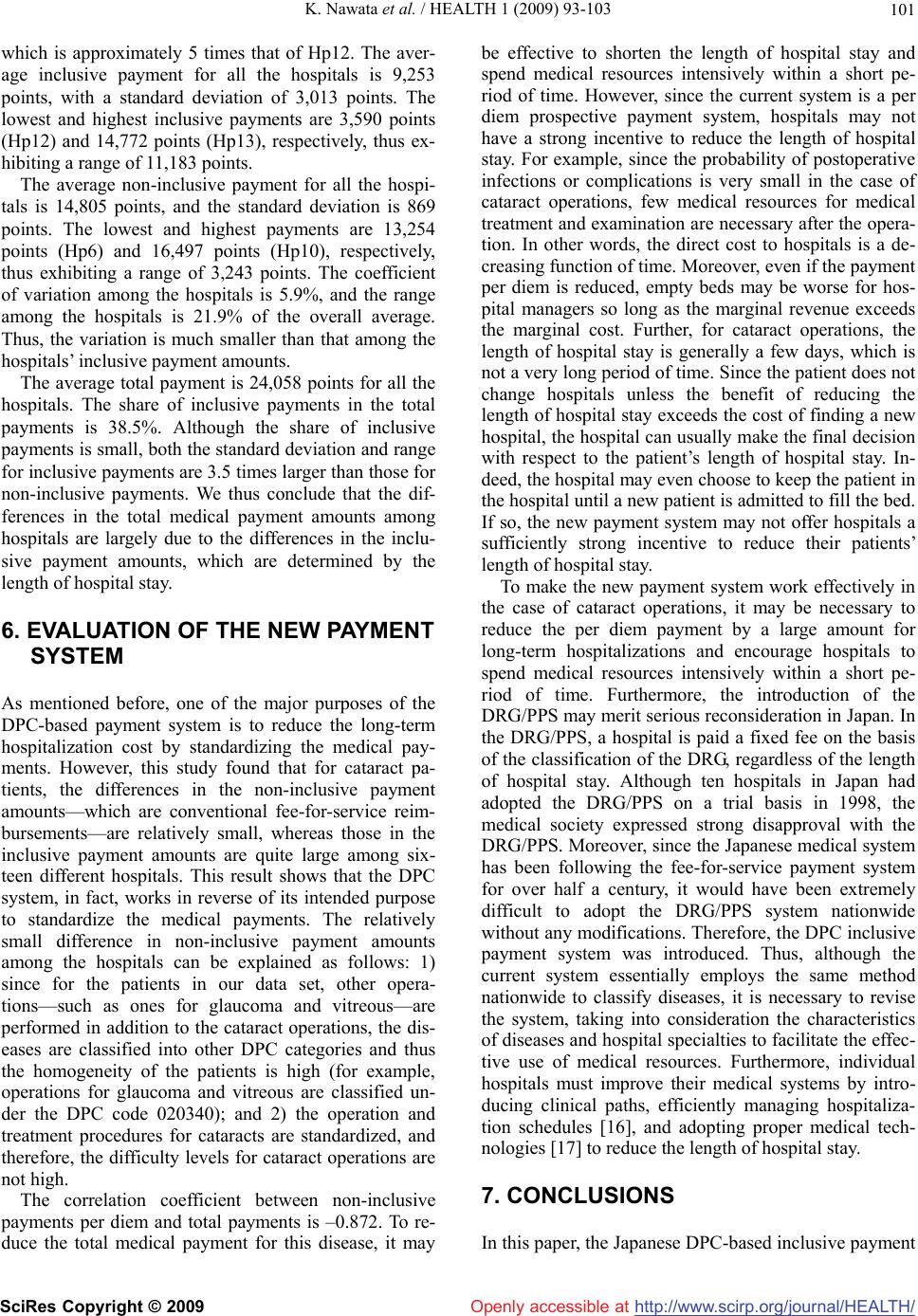 K. Nawata et al. / HEALTH 1 (2009) 93-103 http://www.scirp.org/journal/HEALTH/ 101 Openly accessible at which is approximately 5 times that of Hp12. The aver- age inclusive payment for all the hospitals is 9,253 points, with a standard deviation of 3,013 points. The lowest and highest inclusive payments are 3,590 points (Hp12) and 14,772 points (Hp13), respectively, thus ex- hibiting a range of 11,183 points. The average non-inclusive payment for all the hospi- tals is 14,805 points, and the standard deviation is 869 points. The lowest and highest payments are 13,254 points (Hp6) and 16,497 points (Hp10), respectively, thus exhibiting a range of 3,243 points. The coefficient of variation among the hospitals is 5.9%, and the range among the hospitals is 21.9% of the overall average. Thus, the variation is much smaller than that among the hospitals’ inclusive payment amounts. The average total payment is 24,058 points for all the hospitals. The share of inclusive payments in the total payments is 38.5%. Although the share of inclusive payments is small, both the standard deviation and range for inclusive payments are 3.5 times larger than those for non-inclusive payments. We thus conclude that the dif- ferences in the total medical payment amounts among hospitals are largely due to the differences in the inclu- sive payment amounts, which are determined by the length of hospital stay. 6. EVALUATION OF THE NEW PAYMENT SYSTEM As mentioned before, one of the major purposes of the DPC-based payment system is to reduce the long-term hospitalization cost by standardizing the medical pay- ments. However, this study found that for cataract pa- tients, the differences in the non-inclusive payment amounts—which are conventional fee-for-service reim- bursements—are relatively small, whereas those in the inclusive payment amounts are quite large among six- teen different hospitals. This result shows that the DPC system, in fact, works in reverse of its intended purpose to standardize the medical payments. The relatively small difference in non-inclusive payment amounts among the hospitals can be explained as follows: 1) since for the patients in our data set, other opera- tions—such as ones for glaucoma and vitreous—are performed in addition to the cataract operations, the dis- eases are classified into other DPC categories and thus the homogeneity of the patients is high (for example, operations for glaucoma and vitreous are classified un- der the DPC code 020340); and 2) the operation and treatment procedures for cataracts are standardized, and therefore, the difficulty levels for cataract operations are not high. The correlation coefficient between non-inclusive payments per diem and total payments is –0.872. To re- duce the total medical payment for this disease, it may be effective to shorten the length of hospital stay and spend medical resources intensively within a short pe- riod of time. However, since the current system is a per diem prospective payment system, hospitals may not have a strong incentive to reduce the length of hospital stay. For example, since the probability of postoperative infections or complications is very small in the case of cataract operations, few medical resources for medical treatment and examination are necessary after the opera- tion. In other words, the direct cost to hospitals is a de- creasing function of time. Moreover, even if the payment per diem is reduced, empty beds may be worse for hos- pital managers so long as the marginal revenue exceeds the marginal cost. Further, for cataract operations, the length of hospital stay is generally a few days, which is not a very long period of time. Since the patient does not change hospitals unless the benefit of reducing the length of hospital stay exceeds the cost of finding a new hospital, the hospital can usually make the final decision with respect to the patient’s length of hospital stay. In- deed, the hospital may even choose to keep the patient in the hospital until a new patient is admitted to fill the bed. If so, the new payment system may not offer hospitals a sufficiently strong incentive to reduce their patients’ length of hospital stay. To make the new payment system work effectively in the case of cataract operations, it may be necessary to reduce the per diem payment by a large amount for long-term hospitalizations and encourage hospitals to spend medical resources intensively within a short pe- riod of time. Furthermore, the introduction of the DRG/PPS may merit serious reconsideration in Japan. In the DRG/PPS, a hospital is paid a fixed fee on the basis of the classification of the DRG, regardless of the length of hospital stay. Although ten hospitals in Japan had adopted the DRG/PPS on a trial basis in 1998, the medical society expressed strong disapproval with the DRG/PPS. Moreover, since the Japanese medical system has been following the fee-for-service payment system for over half a century, it would have been extremely difficult to adopt the DRG/PPS system nationwide without any modifications. Therefore, the DPC inclusive payment system was introduced. Thus, although the current system essentially employs the same method nationwide to classify diseases, it is necessary to revise the system, taking into consideration the characteristics of diseases and hospital specialties to facilitate the effec- tive use of medical resources. Furthermore, individual hospitals must improve their medical systems by intro- ducing clinical paths, efficiently managing hospitaliza- tion schedules [16], and adopting proper medical tech- nologies [17] to reduce the length of hospital stay. 7. CONCLUSIONS In this paper, the Japanese DPC-based inclusive payment SciRes Copyright © 2009  K. Nawata et al. / HEALTH 1 (2009) 93-103 http://www.scirp.org/journal/HEALTH/ 102 Openly accessible at system, which was introduced in 2003, was evaluated. We utilized data pertaining to 1,225 patients who were hospitalized for cataract diseases and underwent lens operations from July 2004 to September 2005. The lengths of hospital stay and medical payments among hospitals were compared. The variables found to affect the length of hospital stay were those pertaining to the patients’ sex and age and the presence of secondary dis- eases. We found large differences in the length of hospi- tal stay among hospitals, even after eliminating the in- fluence of patient characteristics and principal disease classifications. The highest average inclusive payment for the hospitals was 3.5 times as high as the lowest payment. Next, non-inclusive payments were analyzed. The variables affecting the non-inclusive payment were the Age 30 dummy, Secondary Disease dummy, and H25.8 dummy. The differences among hospitals in terms of non-inclusive payments based on the conventional fee-for-service system were relatively small. The largest deviation from the average of all hospitals was approxi- mately 10%. Thus, we can conclude that the major dif- ferences among hospitals with respect to medical pay- ments are caused by differences in their DPC-based in- clusive payments, which account for only one-third of the total medical payments for cataract patients. The results of the study strongly suggest that in future revi- sions of the payment system, the characteristics of dis- eases must be considered when determining the efficient use of medical resources. In the present study, only cataract operations were analyzed. To evaluate the DPC-based inclusive payment system more precisely, it is necessary to analyze other important cases such as cancer, cardiac infarction and stroke, and compare the results of the cataract operations with the other cases. These are subjects to be analyzed in future studies. 8. ACKNOWLEDGEMENT The data used in this study were originally collected by the DPC Hos- pital Conference of Japan and are used with the approval of the con- ference’s Data Analysis Division. We are grateful to the anonymous referee for his/her helpful comments. We also thank the research par- ticipants from various hospitals for their sincere cooperation. This study is supported by the Grant-in-Aid for Scientific Research “Analyses of the Japanese Medical Information and Policy using the Large Scale Individual-Level Survey Data (Grant Number: 20243016)” of the Japan Society of Science. REFERENCES [1] OECD, (2007) Health Data 2007: A Comparative Analy- sis of 30 Countries. [2] Okamura, S., Kobayashi, R. and Sakai, T. (2005) Case- mix payment in Japanese medicare, Health Policy, 74, 282-285. [3] Yasunaga, H., Ide, Y. H. Imamura, T., et al. (2005) Im- pact of the Japanese diagnosis procedure combination- based system on the cardiovascular medicine-related costs, International Heart Journal, 46, 855-866. [4] Frank, R. G. and Lave, J. R. (1986) Per Case Prospective Payment for Psychiatric Inpatients: An Assessment and Alternatives, Journal of Health Politics, Policy and Law, 11, 83-96. [5] Newhouse, J. and Byrne, D. (1988) Did medicare’s pro- spective payment system cause length of stay to fall? Journal of Health Economics, 7, 413–416. [6] Rogers, W. H., Draper, D., Khan, K. L., et al. (1990) Quality of care before and after implementation of the DRG-based prospective payment system, Journal of the American Medical Association, 264, 1989-1994. [7] Kahn, K. L., Rusbenstein, L. Draper, V., D., et al. (1990) The effects of the DRG-based prospective payment sys- tem on the quality of care for hospitalized medical pa- tients, Journal of the American Medical Association, 264, 1953-1955. [8] Dillard, G. E. P., J. F., and Smith, H. L. (1999) “The ef- fect of the prospective payment system on rural health care, Accounting Form, 23 (4), 327-358. [9] Newhouse, J. (1996) Reimbursing health plans and health providers: Efficiency in production versus selec- tion, Journal of Economic Literature, 34, 1236–1263. [10] Preston, A. M., Chua, W., and Neu, D., (1997) The diag- nosis-related group – prospective payment system and the problem of the government of rational health care to the elderly, Accounting, Organization and Society, 22, 147-164. [11] Ministry of Health, Labour and Welfare, (2008) Patient Survey 2006. [12] Fedorowicz, Z., Lawrence, D. J., and Guttie, P. (2006) A cochrane systematic review finds no significant differ- ence in outcome or risk of postoperative complications between day care and in-patient cataract surgery, Saudi Medical Journal, 27, 1296-1301. [13] Nawata, K., Niita, A., Watanabe, S., and Kawabuchi, K. (2006) An analysis of the length of stay and the effec- tiveness of treatment for hip fractured patients in japan: evaluation of the revision of the 2002 medical service fee schedule, Journal of Health Economics, 25, 722-739. [14] Box, G. E. P. and Cox, D. R. (1964) An analysis of trans- formation, Journal of the Royal Statistical Society B, 26, 211-252. [15] Ellis, R. and McGuire, T. (1996) Hospital response to prospective payment: Moral hazard, selection, and prac- tice-style effects Journal of Health Economics, 15, 257–277. [16] Vissers, J. M. H., Van Der Bij, J. D., and Kusters, R. J. (2001) Toward decision support for the waiting lists: An operations management view, Health Care Management Science, 4, 133-142. [17] Ghodeswar, B. M. and Vaidyanathan, J. (2006) Adoption of medical technology by hospitals: A review of innova- tion attributes and a conceptual model of the resulting service, World Review of Science, Technology and Sus- tainable Development, 3, 362-380. SciRes Copyright © 2009 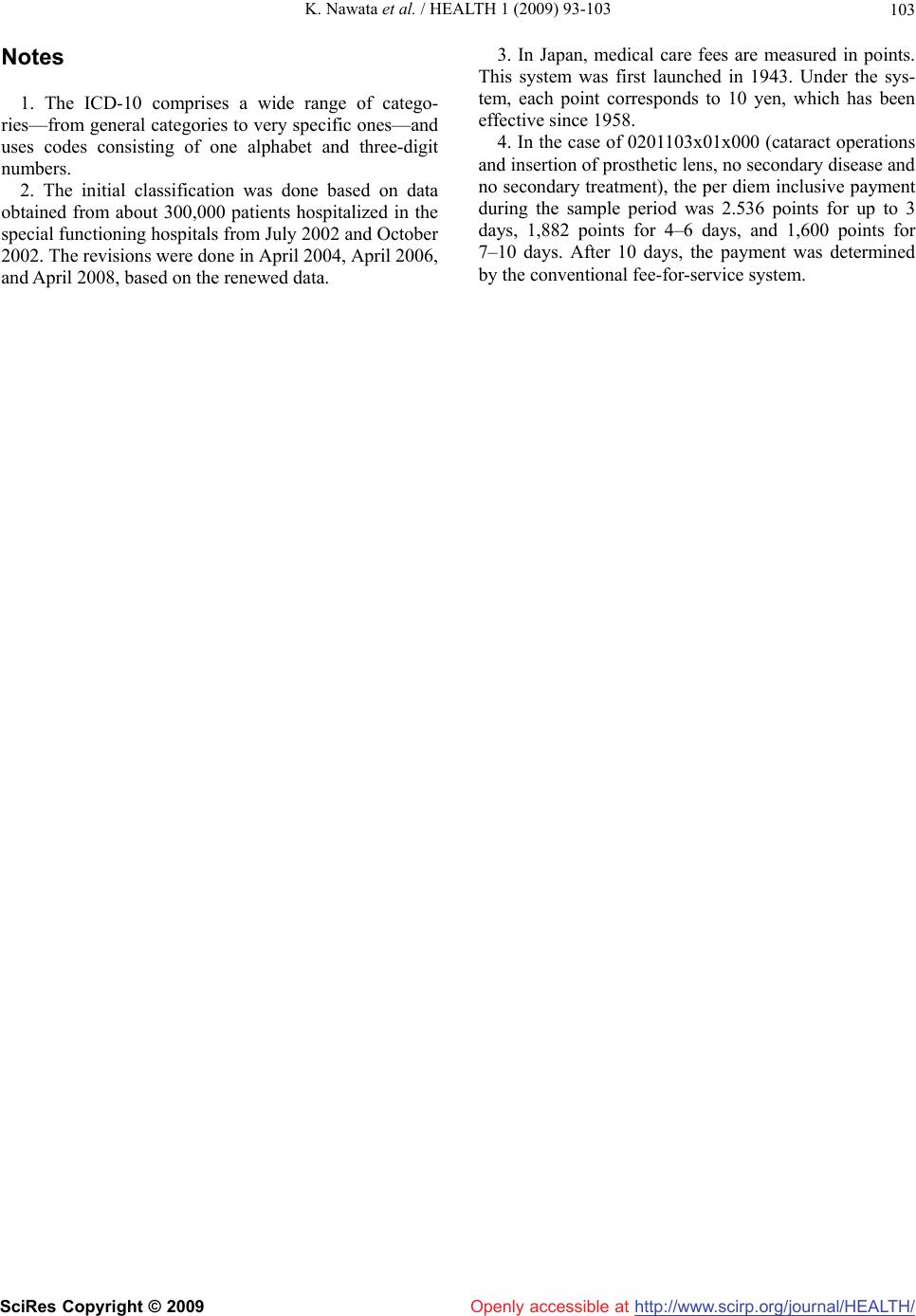 K. Nawata et al. / HEALTH 1 (2009) 93-103 SciRes Copyright © 2009 http://www.scirp.org/journal/HEALTH/Openly accessible at 103 Notes 1. The ICD-10 comprises a wide range of catego- ries—from general categories to very specific ones—and uses codes consisting of one alphabet and three-digit numbers. 2. The initial classification was done based on data obtained from about 300,000 patients hospitalized in the special functioning hospitals from July 2002 and October 2002. The revisions were done in April 2004, April 2006, and April 2008, based on the renewed data. 3. In Japan, medical care fees are measured in points. This system was first launched in 1943. Under the sys- tem, each point corresponds to 10 yen, which has been effective since 1958. 4. In the case of 0201103x01x000 (cataract operations and insertion of prosthetic lens, no secondary disease and no secondary treatment), the per diem inclusive payment during the sample period was 2.536 points for up to 3 days, 1,882 points for 4–6 days, and 1,600 points for 7–10 days. After 10 days, the payment was determined by the conventional fee-for-service system.
|